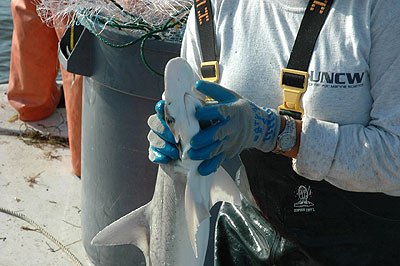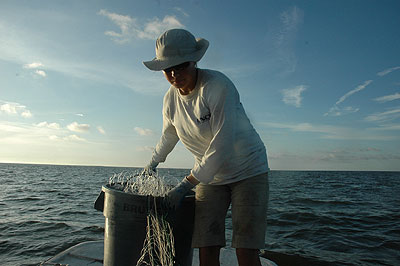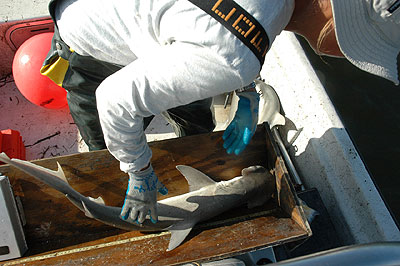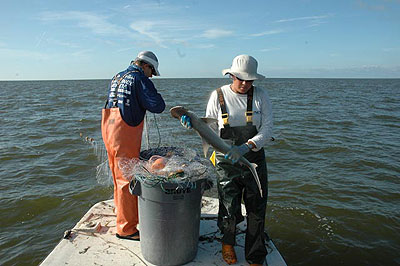
Photo by Bill Kanapaux
The sun had barely broken over the trees as Jason Romine, a research biologist at the Florida Museum of Natural History, guided a boat down the remote Waccasassa River. He and Florida Museum field biologist Johanna Imhoff looked for alligators in a season-long spotting contest as they prepared for a day tagging juvenile sharks in the open waters of the Gulf of Mexico.
The Florida Museum’s shark research boat had barely enough room for its three occupants. The 17-foot flat hull held two large garbage pails for gill nets, three large orange buoys, three anchors, a measuring board, several ice chests and assorted tool kits and waterproof boxes that held an array of gear and scientific equipment.
Three days a month, from May to October, the pair sets gill nets along a stretch of Gulf coast from Suwannee sound to Crystal River as part of a juvenile shark survey sponsored by the U.S. National Marine Fisheries Service. Six research units from Florida to Texas take part in the project, known as the Cooperative Gulf of Mexico States Shark Pupping and Nursery (GulfSPAN) survey.
Since 2003, GulfSPAN researchers have tagged juvenile sharks and collected data on the age, growth and reproduction rates of the Gulf’s shark populations. They all use the same equipment and methods so that the data is comparable across all locations.

Photo By Bill Kanapaux
On this August day, Romine and Imhoff planned to string 600-foot-long gill nets at three preselected random locations within the study area. Each net consisted of six 100-foot sections that were 10-feet deep, and each of those sections had a different mesh size ranging from 3 to 5.5 inches. Sinkers sewn into the bottom of the net kept it stretched down into the water column.
The boat’s GPS unit indicated the boat had neared the first location, about two miles from shore. Romine dropped the engine down to slow speed, found the spot and set the boat’s bow perpendicular to the waves.
Imhoff stepped up to the edge of the bow and dropped an anchor and buoy attached to the end of the net. Romine then set the boat in slow reverse as Imhoff eased the net into the water from two large 32-gallon containers behind her. As the first container emptied, she dropped a small buoy to mark the halfway point and switched to the second container.
After Imhoff attached the final anchor and buoy to the end of the net, Romine moved the boat about a hundred yards away. Here they dropped anchor for the hour-long wait before pulling it back up.
Here they took readings on water temperature, salinity and dissolved oxygen levels from three parts of the water column: surface, middle and bottom. Then came time to talk, read, snorkel or simply rock with the boat as the clouds drifted and gathered into thunderheads in the distance.
The day’s catch
Waiting only an hour helps keep the mortality down, Romine said. But even so, because they use a gill net, not all the fish they catch will survive.

Photo by Bill Kanapaux
Then the time came, Romine and Imhoff stood together on the bow. The boat moved slowly forward, pointing into the waves, as they pulled in the gill net. They usually catch bonnetheads, blacktips, and Atlantic sharpnose sharks. Their first haul of the day brought in 10 live sharks and four dead ones, ranging in size from 1.5 to 3 feet.
They measured and tagged each live shark before releasing it, taking turns as the other continued pulling in the net. Dead sharks were set aside to cut open later to look at stomach contents, which on this day consisted almost entirely of crabs. People might assume that shark research is well funded, but in reality, commercial fishing drives much of the research agenda, Romine said. Fishes such as grouper and snapper receive more research funding than sharks do. For the GulfSPAN project, the Florida Museum receives only $4,500 a year.
Florida Museum researchers have been collecting the juvenile shark data for the last four years. From that data a picture of sharks’ habitat preferences is beginning to emerge, Romine said. Ultimately, he hopes that the project results in enough baseline data to give a good idea of whether the Gulf’s shark populations are going up or down.

Photo By Bill Kanapaux
After running nets at two locations close to shore, Romine took the boat about 8 miles out in 14 feet of water. Here, two- to three-foot swells rocked the boat, lingering after-effects of Tropical Storm Claudette, Romine said. Setting the net proved to be a bit more of a challenge, but Imhoff kept her balance on her perch at the edge of the bow.
The seas were rough enough to pull the net out of place, forcing Romine and Imhoff to locate the displaced anchor and reset its position some 100 yards away. Being farther from shore, they expected to find fewer but larger sharks. But the net came up empty of sharks.
By now the afternoon thunderheads had begun building near Cedar Key, and the day was coming to an end. All told, they had tagged 17 sharks. Another day done, another day of data collection in the books.
Romine turned the boat back toward the direction of the landing and opened the throttle.
Learn more about the Ichthyology Collection at the Florida Museum.